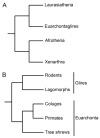Unique Aspects of Human Placentation
- PMID: 34360862
- PMCID: PMC8347521
- DOI: 10.3390/ijms22158099
Unique Aspects of Human Placentation
Abstract
Human placentation differs from that of other mammals. A suite of characteristics is shared with haplorrhine primates, including early development of the embryonic membranes and placental hormones such as chorionic gonadotrophin and placental lactogen. A comparable architecture of the intervillous space is found only in Old World monkeys and apes. The routes of trophoblast invasion and the precise role of extravillous trophoblast in uterine artery transformation is similar in chimpanzee and gorilla. Extended parental care is shared with the great apes, and though human babies are rather helpless at birth, they are well developed (precocial) in other respects. Primates and rodents last shared a common ancestor in the Cretaceous period, and their placentation has evolved independently for some 80 million years. This is reflected in many aspects of their placentation. Some apparent resemblances such as interstitial implantation and placental lactogens are the result of convergent evolution. For rodent models such as the mouse, the differences are compounded by short gestations leading to the delivery of poorly developed (altricial) young.
Keywords: decidual reaction; fetal membranes; placental hormones; primates; uterine NK cell; uterine spiral artery.
Conflict of interest statement
The author declares no conflict of interest.
Figures




References
Publication types
MeSH terms
Substances
LinkOut - more resources
Full Text Sources

